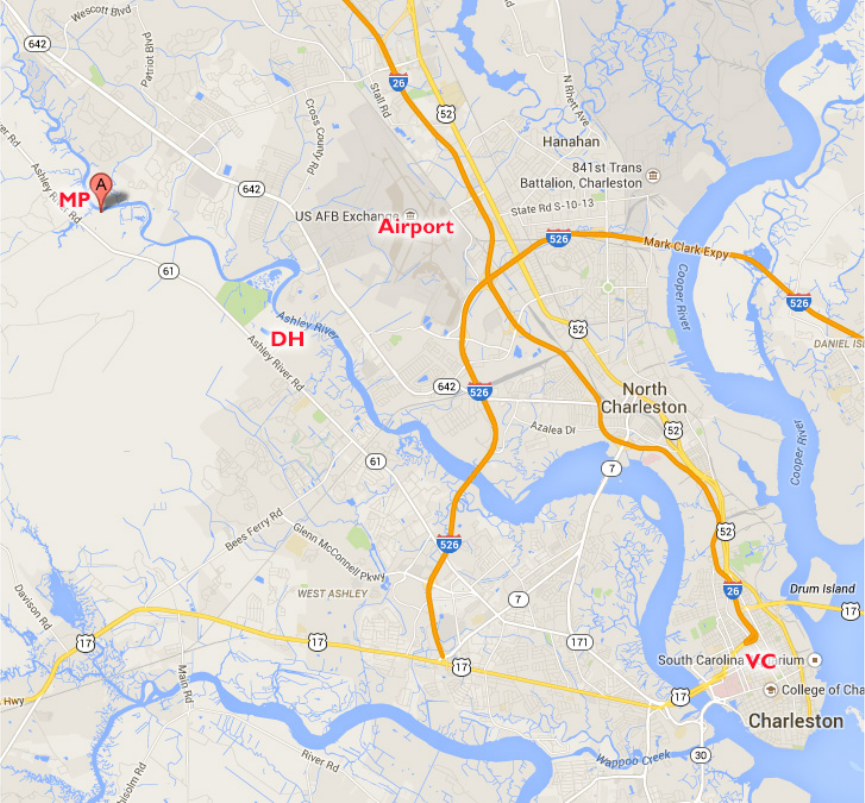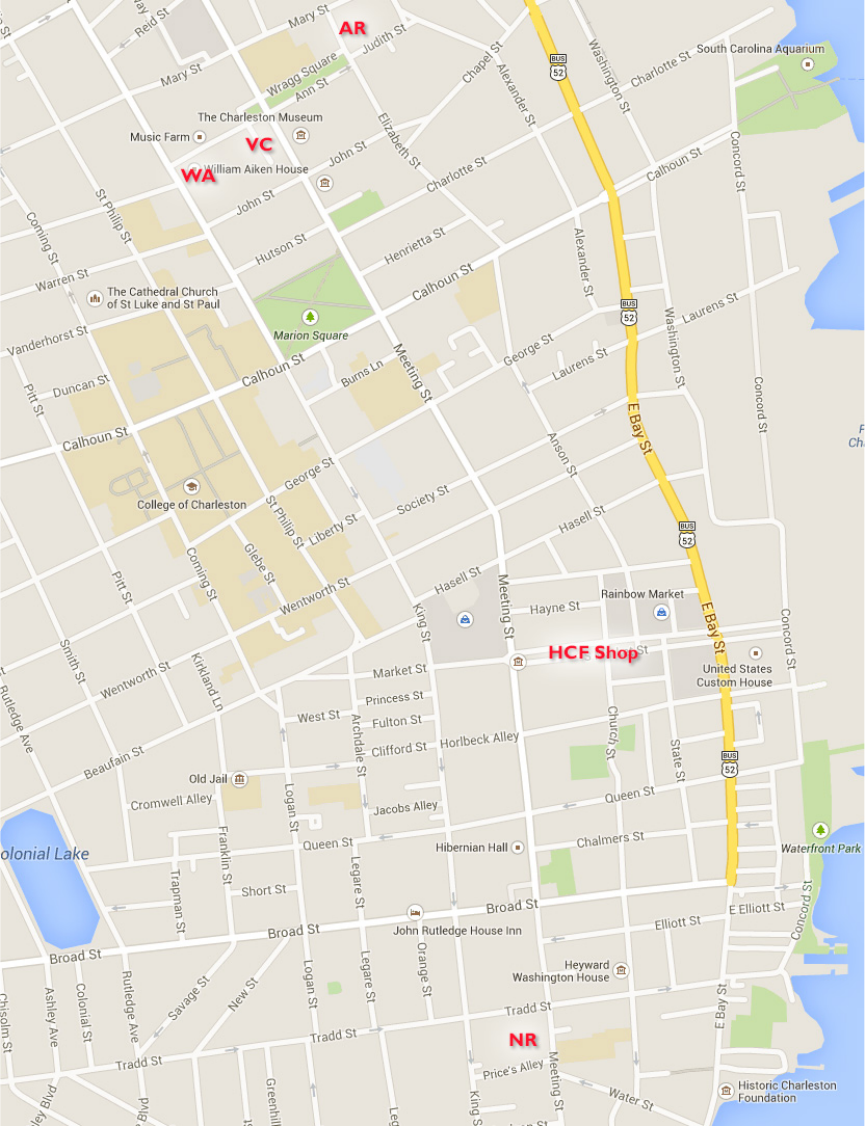
1
Interpretive Inspiration for Historic House Museums
Charleston, South Carolina
Prepared by Max A. van Balgooy, President, Engaging Places, 2014
There’s lots to see and do in Charleston but through this itinerary, you’ll
experience five house museums that are interpreted in very different
ways. Some you’ll like, some you won’t but that’s the point—to clarify your
vision for the interpretation of your historic site. Be sure to verify hours of
operation and admission fees before visiting, and use ordinary precautions
when traveling (and my lawyers want to be sure you know that this information
is provided as a public service; no guarantees or warranties apply). Have an
inspiring trip!
Day One: Downtown Charleston (three to four hours, see Map 2)
1. Park at Charleston Visitor Center (VC on map), 375 Meeting Street,
Charleston. See how they orient visitors to the city and its historic sites. This is
a city crowded with attractions so watch how visitors choose their destinations.
Walk one block to reach the ARH.
2. Aiken-Rhett House (AR on map), 48 Elizabeth Street. Built in the 1820s, it
was the home of the Aiken and Rhett families for 150 years and is not restored.
It’s partially furnished and “frozen in time” with all the layers of history,
probably something you’ve never experienced. An excellent self-guided audio
tour takes you through the house, garden, and outbuildings (including an
urban slave dwelling). Save money by buying a combo ticket with the Nathaniel
Russell House, the next stop on the itinerary.
3. Nathaniel Russell House (NR), 51 Meeting Street. This house is fully
restored and furnished to 1808 and you'll experience it as a guided tour—it’s
the most common interpretive format for an historic house museum. NRH is a
30-minute walk from the Visitor Center and along the way you can visit the gift
shop for the Historic Charleston Foundation (HCF) at the 1840s Charleston
City Market (188 Meeting Street), which is in center of the tourist area (location,
location, location); the 1838 St. Philips Church (John C. Calhoun is buried in
the cemetery across the street); and the historic cobblestoned Chalmers Street.
Option: If you have time afterwards, walk three more blocks south on
Meeting Street to enjoy this beautiful neighborhood and the outstanding
residential architecture that distinguishes Charleston. When you reach
the park, go to the point of the peninsula where the Ashley and Cooper
rivers meet. The view will remind you of Charleston’s value for the
maritime trade and military defense (if you know where to look, you’ll see
Fort Sumter).

2
4. William Aiken House (WA), 456 King Street. The William Aiken House has
been thoughtfully rehabilitated as a wedding and event rental facility by a local
business. Although not open or interpreted to the public, if you are considering
expanding your rental events, you may find WA a useful model. The 30-minute
walk north on King Street takes you through a historic commercial area in
various stages of revitalization, including an “antique district,” “fashion district,”
and “design district”. If you’re a foodie, you’ll find lots of good places to eat and
Yelp, TripAdvisor, and Southern Living are your best bets for recommendations.
5. For an overnight stay, drive to the Inn at Middleton Place (MP), 4290
Ashley River Road. While there are many hotels near the Visitor Center, I
recommend the Middleton Inn because it makes the next day more efficient and
cost effective, plus you can experience how modern architecture can
appropriately fit within an historic site. The signs for the Middleton Inn are
simple and small, so look for them after Drayton Hall and Magnolia Plantation.
If you pass Middleton Place (the house museum and gardens), you’ve gone too
far.
Day Two: Ashley River Road (five to six hours, see Map 1)
6. After breakfast, walk from the Inn to Middleton Place (admission is
included with your lodging), which features acres of formal gardens that were
begun in 1741, making them America’s oldest landscaped gardens. You’ll be
tempted to wander, but if you have a site with a large landscape, walk straight
through to the public entrance with the parking lot, admission reception,
museum shop, garden market, and restrooms. It’s all designed with a light
touch on the landscape, emphasizing openness and diffusion. There is a House
Museum that provides guided tours of the 1755 flanker building that became
the family home when the main house was destroyed during the Civil War. The
house appears to feature period rooms, however, they are actually exhibits of
art, furnishings, and artifacts from the family, providing a different interpretive
format: an exhibit gallery. Nearby is Eliza's House, a two-family duplex from
the 1870s that has a panel exhibit on one side that interprets the history of
enslavement and freedom in America and the other side has period rooms
representing an African American family after Emancipation. Twice daily hour-
long guided walking tours on African American history go “beyond the fields” to
discuss domestic life, labor at the rice mill, and religion at the plantation
chapel. Have lunch either at the restaurant or garden market before driving to
Drayton Hall, the next stop.
7. Drayton Hall is often viewed as the poster child for historic house
interpretation because it does the seemingly impossible—effectively interpret an
historic site without any furnishings. Yes, the rooms are empty. In a
controversial move, the National Trust did not restore the house but preserved
it to the time it was received from the Drayton family in 1974. It’s a reminder
that a good tour of an historic house doesn’t need furniture or a
restoration. The house by itself can tell compelling stories with thoughtful
planning—don’t overlook the biggest object in the collection in your
interpretation. Guided tours explore Drayton Hall inside and out, discussing

3
the people who lived and worked there from its construction in 1738 to the
1970s, and also incorporate current challenges in historic preservation on site
and in the region. Twice daily hour-long interactive programs focus on the
connections, contributions, and experiences of African Americans, an
alternative format to a guided tour.
Map 1: Charleston Overview

4
Map 2: Downtown Charleston
